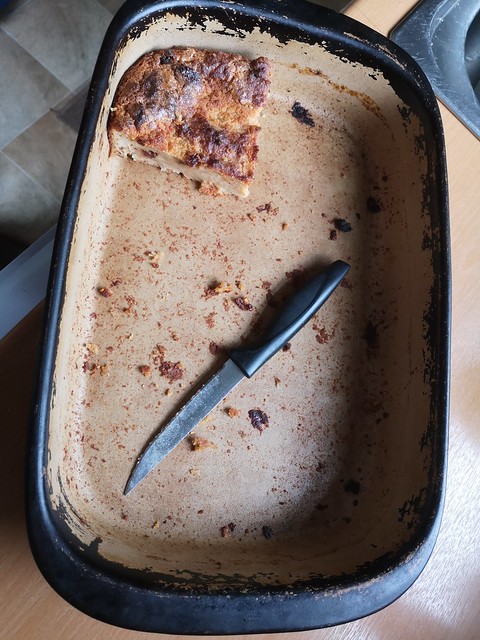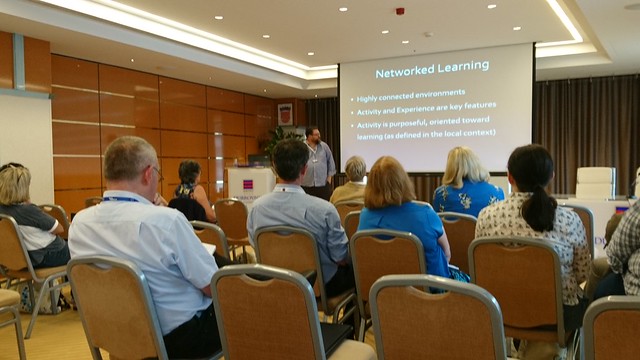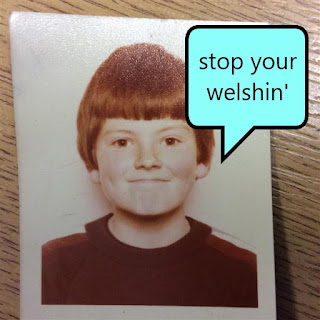With apologies for not putting anything new in this blog for ages - part of the reason for that is hanfod.NL kicked in and that has been quite productive. Maybe check it out...?
Friday, May 3, 2024
Saturday, March 6, 2021
Automatic translation and bilingualism
Monday, November 9, 2020
Promoting connections around the fringes of virtual classes
Who remembers queuing in awkward silence... which eventually led to carefully negotiated acquaintance and possibly lifelong friendships, or at least learning where you were meant to be next? Social Network Analysis takes a look at who interacts with who on the basis of digital activity traces in terms of the data recorded about interactions. I'm wondering how a typical SNA map of a class/lecture would look before and after the COVID flip to online versions. We used to worry about student chatter in lectures. While this is happening less, if at all, in online classes, and we are glad to still bring students to an 'event', they now join with blinkers on: zooming into the session and back out again causes a kind of tunnel vision with respect to peers. In SNA terms, this would look like a particularly tight hub and spoke network. Although a lecture format is sometimes mocked for requiring one-way traffic from the lecturer to the students, in fact there is a lot more latitude for connections in a lecture setting than zoom, unless there are deliberate efforts to break up those hard-wired spoke-to-hub connections. There actually is no-one else in the room to turn to - what chance purple and black will rub virtual shoulders? How can we enable or promote connections between students? Would putting students into breakout rooms at regular intervals be enough to enable the helpful social learning milieu...? Would #togethermode ...?
Tuesday, May 12, 2020
A Networked Learning Disposition? Round Table at NLC2020
I'm delighted to be hosting a 'round table' discussion on the first day from 13.30-15.45. I'm expecting a lot more people in the room but also, because there's no physical movement required to room-hop, I think people will be far more transient in their attendance - there will be drive-by's.
The topic of 'disposition' is one that has been gnawing at me for a while. The round table format should allow plenty of time for others to also chew back at it. The question I have is whether there is a disposition towards being the ideal networked learner. It relates to a previous question I framed on this blog in 2008, 'what characterises the networked learned'? Are there things about you (apart from sheer privilege!) that make you a good match for networked learning? This is not the same as learning styles although some of the trait words used there may crop up here. I've been working up a mindmap about disposition and I'm looking to my partners in next week's round table discussion to help with developing and refining ideas and implications of this for networked learning practice, design and research. The mindmap for that is embedded below - it's a wikimap so if you want to, go ahead and add some ideas. It makes sense to try and write it all up and I'm keen to acknowledge any contribution. Probably there are whole swathes of knowledge about 'disposition' I'm unaware of so even a tip-off would be appreciated. If you wish to suggest any, please go ahead and add them to the References GoogleDoc: https://bit.ly/nlc2020dispositionrefs
For a bit more context, Michael Gallagher took up the idea of 'disposition' for his paper at Zagreb's NLC2018. His paper is in the NLC archive and his blog post includes the slides. Among many excellent points, he addressed the critique of 'disposition' being deterministic: post-human perspectives of shared agency should also allow us to avoid that dead-end.
It was great to share the same session with Michael to present my paper on mobilage, originally blogged here in 2017.
Wednesday, April 22, 2020
NLindex
There are lots of ways of providing an index. Google Scholar does some of it. I don't think any of the databases cover the NL conference archive, and we might want to include other non-NLC sources anyway. We have a saying, 'he who has the vision gets the job'.
Joe used Kumu for his Knowledge Hub. Kumu allows for various ways of presenting the same information, so was preferred over CMAPS, as good as that is. Kumu's free for public maps. Anything that requires effort needs to be reasonably durable and Kumu appears to have that. It also has an CSV import, which, data cleaning notwithstanding, could save a lot of time hand-coding. There may be no way to avoid some of that.
Although in lockdown, Alice kindly sent me 3 exports from the SCHED app used in the previous 3 conferences. So, when I can get to it, this presents a viable way forward. It will still require a fair bit of data cleaning and there are some decisions to make... E.g. whether to re-host the papers, where possible. If anyone is interested to help with this project, do get in touch. There could be some bread pudding in it for you...

Wednesday, October 9, 2019
Venn Diagrams, digital scholarship
In my experience and, not least because of my incredible life privileges, I find it is relatively easy to 'do digital', and I have a disposition so to do. I find that others do not have this disposition, but still 'get the job done'. Through earnest scholarship, they develop their own practices which may be more or less digital, even if vicariously digital (e.g. getting someone else to type things up), but they cannot avoid having to use a computer occasionally.
Recently, I have been teaching the concepts of searching for literature using Boolean operators and I love a Venn diagram to make the point. I think they also help to make a point about 'the digital' and what different people take up in the context of academic work.
In the first diagram, we have Scholarly OR Digital practices. In some ways, this reflects the reality that we all swim around in bits of both.
There are still people, you might know some, you know, the kind that own 'brick' phones, if they have a mobile at all. These are the 'NOT' people. If they 'do' social media, they do it because someone else is handling it for them. Perhaps they are self-confessed draconian Luddites but their scholarship and contribution would be generally deemed successful.
Then there are the 'AND' people, who scarcely do anything without it in some way 'being digital'. Are they any more successful at scholarship for this than the NOT's? What mattered?
[Apology - this is an 'early version' of the AND diagram - it should be shaded in the middle/overlap but that's a bit tricky in google drawings so I will/may attend to that at another time.]
Appendix: Robin Goodfellow defines the scholarship orientation
This orientation [scholarship] values critical reflection, the cumulative aggregation of knowledge and understanding, distinct modes of operation relating to evidence and the war- ranting of its reliability, and the ethic of enquiry as a primary motivation (Andresen 2000; Cowan et al. 2008; Courant 2008). The combination of these characteristics is what distinguishes the construction of academic scholarly knowledge from other kinds of knowledge production (factual knowledge, practical knowledge, common-sense, morality, the wisdom of crowds, etc.). The existence of communities dedicated to these values in a general sense also distinguishes the sites of production of academic scholarly knowledge (universities, research institutes, museums) from most other arenas of social knowledge practice. (Goodfellow 2013 , p. 69)
Wednesday, May 16, 2018
NL conference does NL
 |
| Who is doing 'Networked Learning' here? |
Networked LearningWe define 'networked learning' as:learning in which C&IT is used to promote connections: between one learner and other learners, between learners and tutors; between a learning community and its learning resources.Some of the richest examples of networked learning involve interaction with on-line materials and with other people. But use of on-line materials is not a sufficient characteristic to define networked learning.The interactions between people in networked learning environments can be synchronous, asynchronous or both. The interactions can be through text, voice, graphics, video, shared workspaces or combinations of these forms. Consequently the space of possibilities for networked learning, and the space of potential student experiences, is vast.
PS. I foolishly determined to write this blog post on my phone. This went ok in evernote, even if the hyperlinks were not automatically being picked up so that gets a real faff to sort out on a phone. Then I copy/pasted the text into the blogger app which went ok apart from losing the links again - should have known better. The next gotcha was when I dared to add a picture to the post. This was possibly too high resolution for the app to cope with at some level so it failed to publish and I had to copy the text into another new post but by that time had lost the will to try and tidy up the hyperlinks etc. This morning, I have revised the text, added the hyperlinks, added a photo, tweaked formatting - so much easier than on my phone.


